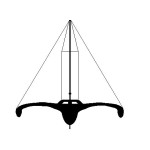D/T-3
Trimaran, Newick
60' x 34' x 8 Tons
5-Ft. Dia. Shewmon
Force 10 Conditions
File D/T-3, obtained from Thomas Follett, Orange City, FL. - Vessel name Rogue Wave, Maxi ocean racing trimaran designed by Richard Newick, LOA 60' x Beam 34' x Draft 8' (board down) x 8 Tons - Drogue: 5-Ft. Diameter Shewmon (sea anchor) on 100' x 3/4" nylon braid rode. - No bridle - Deployed in a gale in shallow water (50-60 fathoms) about 80 miles west of Tunisia with winds of 50 knots and unstable seas of 15 ft. - Vessel's stern lay at a 25° angle during 36 hours of deployment with very little drift.
This is the second of two major reports obtained from veteran delivery skipper Tom Follett (see also previous file). The occasion of this file led to the publication of the Shewmon Paper, Sea Anchor - Rode Tactics (1986, Shewmon, Inc.)
Multihull sailors may recall that Rogue Wave once belonged to the late, great Phil Weld, whose previous 60-ft. trimaran Gulfstreamer was capsized by a rogue wave in the Atlantic, later to be picked up by the Russian ship Boreas and taken to Odessa, where she collected dust for many years. Some time after Phil passed away, Rogue Wave was purchased by a wealthy individual of the United Arab Emirates. Tom Follett and crew were delivering the big tri when the incident occurred.
Rogue Wave departed Almerimar, Spain, in February, bound for Sidi-bu-Said, Tunisia. Two days later and some 100 miles north of the African coast - in shallow water - she ran into an Arifi (a cousin of the Scirocco), packing 45-50 knot winds. The waves were about 15 ft. high and 200 ft. from crest to crest. Rogue Wave was doing about 10 knots on bare poles with her 117 sq. ft. wingmast feathered when the 5-ft. diameter Shewmon sea anchor was jettisoned over the stern.
The crew had led about 100 feet of the rode through some deck hardware to three cockpit winches, thinking that they could let out more line afterwards. When the sea anchor took hold it brought the huge trimaran to a jarring halt, yanking some minor hardware out of the deck. The three cockpit winches held, however.
Tremendous tension was noted in the rode, "too great to risk paying out any more line after we got the thing made fast," quoting Follett. Notwithstanding, the sea anchor held the stern into the seas for 36 hours, until the storm abated. According to Shewmon, "When the sea anchor was retrieved, many of its longitudinal seams were found ruptured despite its tug-tested 10,000 lb. pull rating. The wind force on the boat was well under 1,000 lbs., so what caused the other 9,000 lbs. of pull?" Dan Shewmon then draws from Bowditch table 3303 showing that the circular surface water particulate speed for the reported 15-ft. waves must have been 3 knots.

When the boat was moving downwind on a crest at 3 knots the sea anchor must have been moving upwind at 3 knots in the adjacent trough. This adds up to a divergence of 6 knots, "which explains the missing 9,000 lbs. and the ripped out hardware and ruptured seams." (Quoting from the Shewmon paper, Sea Anchor - Rode Tactics.) The trouble appears to have been caused by a rode that was too short. Had the crew tied off 400-500' of rode (instead of only 100') the initial shock and the subsequent system loads would have been a great deal less. (Walter Greene seems to have run into a similar problem in File D/C-1).
Rogue Wave spent a few weeks in Tunis and then departed for Crete. About 100 miles from Sicily she ran into a Gregale (a cousin of the Mistral). This time Follett used a smaller, 3-ft. diameter Shewmon drogue. Transcript:
About a hundred miles or so east of Sicily, we streamed our smaller (3-ft. diam.) Shewmon drogue in an easterly wind of Force 7, in order to avoid plugging to windward. Worked much better. Lots of shipping about and we could maneuver with the engine whenever necessary [drogue in tow]. Didn't stop us but slowed us down a lot and was very comfortable. Not nearly as much strain (of course the wind was only about Force 7) and we could easily vary the length of the rode.
EPILOGUE: Tom Follett passed away shortly after Victor Shane obtained invaluable feedback from him. He was a close friend of Richard Newick and delivered many of Dick's fantastic wind machines to exotic places all over the world. During his lifetime he made fifteen Atlantic crossings and numerous other passages, successfully negotiating a variety of heavy weather situations in monohulls and multihulls.
Tom knew the sea. He could discern subtle differences between gales and compensate for them ahead of time. He knew when to heave-to in a H-28 monohull and when to deploy a drogue on a 60-ft. racing trimaran. We are very fortunate that just before passing he left some of his priceless knowledge to us.
